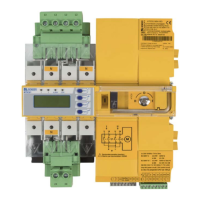ATICS-2-ISO_D00046_04_M_XXEN / 03.2021 83
ATICS-2-63A-ISO
8 Troubleshooting
8.1 Fault and alarm messages
In the event of an alarm, the messages of the ATICS® transfer switching and monitoring device will ena-
ble you to narrow down the possible causes. Some messages may point to several causes. The follow-
ing possible faults are indicated by messages on the ATICS® display:
• Plain text messages
• Fault messages with error code
8.1.1 Plain text messages
Fault/message Description Action
Failure line xx (xx
stands for: 1, 2, AV, SV,
UPS, BSV), undervolt-
age or overvoltage
Voltage is no longer available on line 1 or
line 2
Channel 1 = Line 1,
Channel 2 = Line 2
• Measure voltage on line xx.
• Check cause.
• Eliminate fault in the system.
• Check the setting for voltage and
hysteresis.
Failure line 2 when
set to
System > Line G
Generator delivers no voltage
within the set time t(GenMax)
Voltage
Insulation fault IT system has insulation fault • Search for insulation fault.
• Eliminate fault in the system.
Overload Current consumption too high .
Sporadic indication of load current, chang-
ing without any apparent reason. The fault
can also be caused by an (impermissible)
connection between k or l and PE.
• Check settings for transformer load
current.
• Switch off any loads that are not
urgently needed.
• Separate connection between k or
l and PE.
Overtemperature Temperature in the IT system transformer is
too high
• Switch off any loads that are not
urgently needed.
CT connection Short circuit or interruption of connecting
wire has been detected: measuring current
transformer STW2 (T4), isolating transform-
er load, channel 10
• Check connecting wire of measuring
current transformer.
System connection Connection to the IT system interrupted
or voltage in the system being monitored
below 150 V
• Check connection of ports L1/IT,
L2/IT to the IT system.
• Check voltage in the IT system
Earth connection Connection to PE interrupted
Impermissible connection Z1 or Z2 to PE
• Check that connections E and KE
are each connected to PE with two
separate lines.
• Ensure that Z1 and Z2 are not con-
nected to PE.

